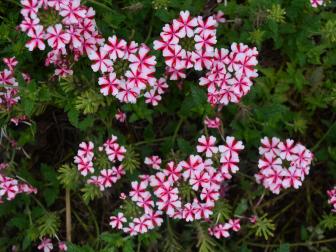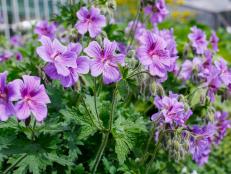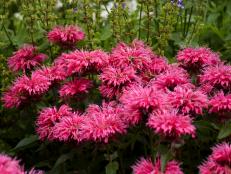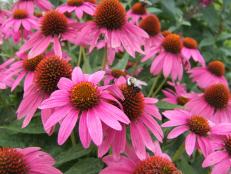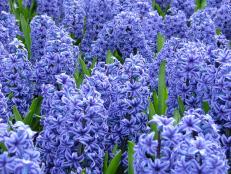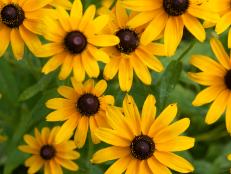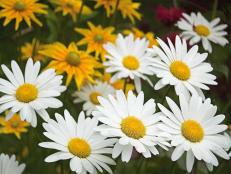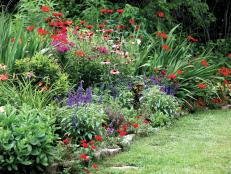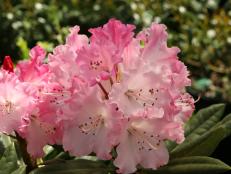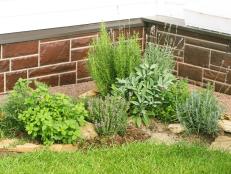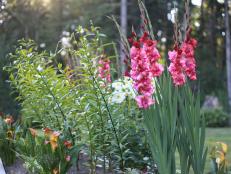How to Plant and Care for Verbena
Verbenas add a punch of long-lasting color to gardens and containers from spring into fall. These easy-to-grow, reliable beauties love the sun.

Verbena 'Aztec Magic Purple'

From spring until frost, tough-as-nails verbenas (Verbena officinalis) open clusters of red, pink, purple, blue, lavender, cream and white flowers. The plants, which originated in the Americas and Europe, are available as annuals and perennials.
Grow verbenas in hanging baskets, as groundcovers, in beds and borders or pots, or let them trail over walls. Once you know how to plant verbena, you'll have three seasons of color.
How to Grow Verbena
Perennial verbenas are hardy in USDA Zones 7 to 11 and bloom the first year after planting. Some are low-growing trailers, but upright types can reach 6 feet. Perennial types usually come back for two or three years and then die, but some drop seeds and self-sow.
Most verbenas, however, are annuals and grow 6 to 18 inches tall. Both types bloom for a long time, but annuals decline faster than perennials in hot, humid weather.
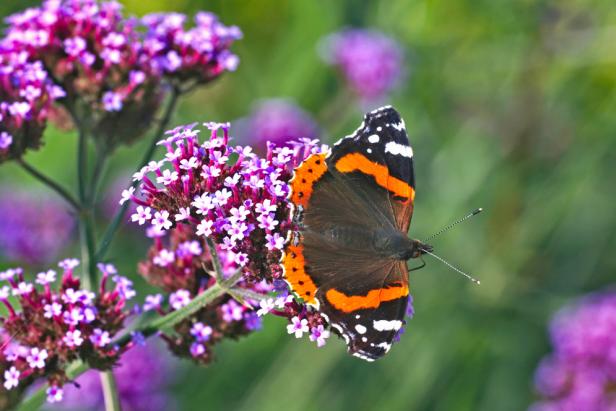
Shutterstock/Gardens by Design
Butterflies love Verbena bonariensis.
Plant verbenas in fall, spring or summer and keep them moist until their roots are well-established. Trim perennial verbenas as needed, usually once or twice in the summer.
How to Plant Verbena
Light
Give verbenas eight to 10 hours of full sun daily. They grow best in well-draining soil amended with compost or fresh potting soil, but can adapt to most soils.
Water
Verbenas need an inch of water a week from rainfall or a hose. They can't take soggy soil but don't let them dry out.
Fertilize
In the spring, apply a slow-release fertilizer, following the directions on your product. Feed verbenas in hanging baskets or pots with a liquid fertilizer monthly or as the label indicates.
More Verbena Plant Care
Pinch verbena tips to keep the plants full and encourage branching. When flowering slows down, cut back their height by about 1/4 and fertilize and water thoroughly. Trim perennials lightly in the fall and harder in the spring.
Verbena Care in Pots and Gardens
Give verbenas good air circulation and avoid wetting the foliage to prevent diseases. Space them as directed on their tags or seed packets.
What is Lemon Verbena?
What is the difference between verbena and lemon verbena? Aloysia citriodora, or lemon verbena, isn't a verbena at all. Cooks use the leaves of this shrubby, woody herb, which is hardy in Zones 8 to 11, to add a lemony flavor to drinks and foods. Note: It's toxic to pets and horses.
Propagating Verbena
Some verbenas self-sow. You can also collect the ripened seed pods, let them dry for a week and rub them to release the seeds inside. The following spring, scatter the seeds over moist soil but don't cover them. They'll sprout in a few weeks. Be aware that you may not get plants that look like the parent if you grow hybrid seeds.
You can also propagate verbena from 3-inch cuttings taken in late spring. Remove all but the top one or two sets of leaves and put the cuttings in a pot of moist, loose, well-draining medium. Cover the pot with a plastic bag for six weeks, or until roots form, and transplant the cuttings.
Verbena Problems
- Powdery mildew is a fungal disease. To avoid it, give your plants good air circulation and don't get the foliage wet when watering. Avoid overcrowding and clean up old plant debris.
- Botrytis blight, which looks like a fuzzy, gray fungus, can discolor verbena flowers and cause wilting. Remove and destroy infected plant parts and treat with a fungicide labeled for this disease.
- Knock off aphids with a spray of water or Neem oil.
- Use sticky traps to catch adult thrips and treat larvae with Neem.
- Control spider mites with insecticidal soap or horticultural oil, or knock off whiteflies with a spray of water.
- Banish snails and slugs by placing an aluminum pie plate near your infested plants. Fill it with beer to attract them, and they'll crawl in and drown.
Buy Supplies
Verbena Cultivars, Varieties and Species
There are hundreds of verbenas in various sizes. Read plant tags to find the one that's right for you. Most are magnets for butterflies, bees and hummingbirds.
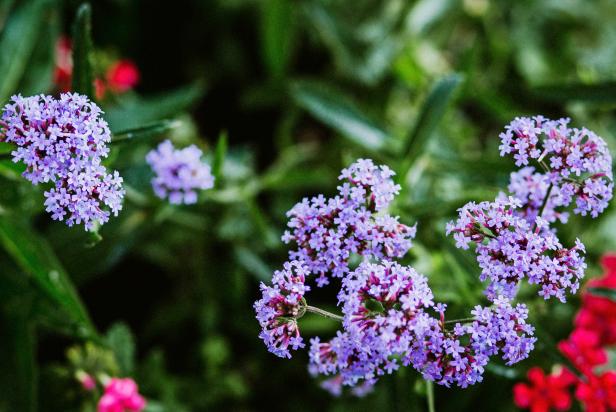
Cassidy Garcia Photography
Verbena bonariensis 'Lollipop'
Purpletop verbena (Verbena bonariensis) — This common perennial verbena is an upright variety that can reach 6 feet tall. It has petite, lavender flowers and slender, square stems. Also known as purpletop vervain, it self-seeds easily.
'Vanity' (Verbena bonariensis) — Use this compact variety, an All-American Selections winner, in cottage-type plantings. Deep blue-purple flowers are held atop 30-inch plants.
'Homestead purple' (Glandularia or Verbena canadensis) — A popular perennial verbena, this trailer has deep purple flower clusters and grows 12 inches tall.
'Appleblossom' (Glandularia or Verbena canadensis) — Plant this perennial for its light pink flowers with dark pink centers. It reaches 14 inches tall.
Vivacious Verbena 10 Photos
An extended bloom time and heat tolerance are among this bright annual's attributes.
Blue vervain (Verbena hastata) — Also known as blue verbena or swamp verbena, this native perennial wildflower has blue-violet blooms and grows 2 to 5 feet tall.
Moss verbena (Verbena tenuisecta or Glandularia pulchella) — This perennial with fine-cut leaves often stops blooming in hot weather, but flowers reappear from late summer into fall. It grows to 12 inches.
Rigid verbena (Verbena ridigda) — Scented flowers distinguish this perennial, also called tuberous vervain. It spreads by rhizomes (underground stems), grows 1 to 2 feet tall and ranges in color from purple to lavender.
Verbena Beats series — Available in blue, red, white, purple with white, or red with white, the varieties in this series resist powdery mildew. They're compact, so they're perfect for outdoor tabletops or balconies.
Verbena Quartz and Quartz XP series — "XP" stands for extra performance. Start this verbena, bred to propagate from seeds, three months before your last spring frost. Available in pink, purple or white, the trailing plants grow to 10 inches.
Verbena EnduraScape series — Think "landscape." This verbena sometimes overwinters to Zone 7 but otherwise behaves as an annual. Its low-growing, spreading habit is suitable for large areas. It can also trail over walls, spill from big window boxes or tumble out of half whiskey barrels. It tolerates very cold and very hot weather. Look for it in bi-colors and shades of soft pink, dark red, white, blue and magenta.
Verbena Firehouse series — These trailers bear flowers with an ombre-like effect. They come in colors with a modern take, like coral and soft lavender.
Verbena Lanai series — Grow this early-blooming, annual series for its excellent resistance to powdery mildew. The 12- to 18-inch plants have a semi-trailing habit and come in lime green, magenta, sky blue and more. Lanai Twister verbenas are available in color combinations like purple and white.
Verbena Obsession series — You can grow this series from seeds. It includes light blue, apricot, coral and burgundy flowers, among other colors. Obsession Twister verbenas are available in combinations like purple with white or red with white.









